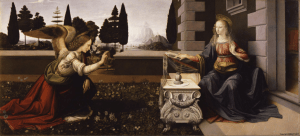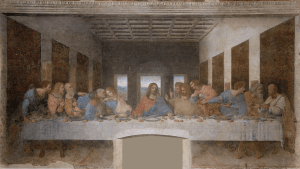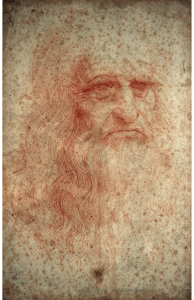There have been many influential and significant figures in the arts and sciences over the centuries, but few if any have matched Leonardo da Vinci. Born, opens a new window in Anchiano near Vinci outside of Florence in 1452, he was the illegitimate first child of Piero da Vinci, a notary, and a peasant named Caterina. He spent his childhood in his father's household. His family moved to Florence during his teen years where, having demonstrated some talent at drawing, he began his artistic training under the tutelage of Andrea del Verrocchio in the last half of the 1460s.
During this early Florentine period of his career, Leonardo joined, opens a new window the painters' guild, completed his apprenticeship with the renowned Verrocchio, and continued, opens a new window to work alongside him before opening his own studio in about 1478. There are several existing examples of his talent as a painter from this time in Florence, including the Annunciation (left) and his unfinished Adoration of the Magi.
In about 1482, Leonardo moved, opens a new window to Milan to work in the court of Duke Lodovico Sforza, where he remained until Sforza's downfall at the hands of French troops in 1499. This time in Milan saw the creation of two of his most famous works: The Virgin of the Rocks, painted in 1483, and The Last Supper (right), a fresco dating from about 1495-1498 in the Santa Maria delle Grazie in Milan. He also produced a clay model for an equestrian monument to the duke's father, but he ceased work on the project and the model was destroyed.
Upon leaving Milan, Leonardo then spent time, opens a new window in Mantua and Venice before returning to Florence in 1500. This second period in Florence was his most productive, opens a new window. He conducted extensive anatomical research, dissecting and studying cadavers at the hospital of Santa Maria Nuova and recording his observations. He painted, opens a new window the famous Mona Lisa during this period, as well as the Virgin and Child with St. Anne.
In 1506, he returned, opens a new window to Milan to work as an engineer in service to King Louis XII. These later years, opens a new window in Milan were marked by a greater interest in scientific pursuits. He spent several years in Rome from 1513 until he relocated to France, opens a new window at the invitation of King Francis I, where he served as first painter, architect, and mechanic. Leonardo died at his home in Amboise, France, on May 2, 1519.
In addition to his multiple paintings, sculptures, and other works of art that survive, Leonardo left behind more than 3,500 pages, opens a new window of notes and sketches that demonstrate his genius and skill across many fields: mathematics, visual arts, anatomy, philosophy, the physical sciences (including astronomy and earth sciences), engineering, city planning, and architecture. His notes reveal an ability to conceptualize inventions, opens a new window far ahead of his time, such as models of flying machines and military tanks.
The St. Tammany Parish Library has a rich selection of resources about Leonardo, some of which are included in the list below. Be sure to check them out to learn more about him!
Leonardo da Vinci was the model of the Renaissance man: curious about and knowledgeable in the fields of art, music, science, mathematics, and much more. The St. Tammany Parish Library has many resources for you to learn about his life, his works, and his legacy! Please Note: In order to bring you new and interesting titles, Hoopla content is updated monthly, and these titles may not be available in the future. To find the latest titles, please visit www.hoopladigital.com.





Add a comment to: Leonardo da Vinci